Clinical outcome of diabetic foot ulcers treated with negative pressure wound therapy and the transition from acute care to home care
- PMID: 18577133
- PMCID: PMC7951261
- DOI: 10.1111/j.1742-481X.2008.00466.x
Clinical outcome of diabetic foot ulcers treated with negative pressure wound therapy and the transition from acute care to home care
Abstract
Diabetic foot ulcers affect millions of people in the United States of America and impose tremendous medical, psychosocial and financial loss or burden. Negative pressure wound therapy (NPWT) is generally well tolerated and appears to stimulate a robust granulation tissue response compared with other wound healing modalities. This device may be a cost-effective adjunctive wound healing therapy. This literature review will focus on the clinical outcome of diabetic foot ulcers treated with NPWT, its implication in the transition from acute care to home care, factors that might influence clinical outcomes in home care as well as quality-of-life aspects in these patients. Patient care for diabetic foot ulceration is complex and necessitates multiprofessional collaboration to provide comprehensive wound care. It is clear that when we strive for limb preservation in this most high-risk population, it is important to have an available versatile, efficacious wound healing modality. There is a need for an easy transition from acute care to home care. Resources need to be combined in a collaborative and synergistic fashion to allow patient to perform many daily living activities while receiving the potential benefits of an advanced wound healing modality.
Conflict of interest statement
The authors have declared no conflicts of interest.
Figures
References
-
- Singh N, Armstrong DG, Lipsky BA. Preventing foot ulcers in patients with diabetes. JAMA 2005;293:217–28. - PubMed
-
- Boulton AJ, Vileikyte L. The diabetic foot: the scope of the problem. J Fam Pract 2000;49(11 Suppl):S3–S8 [in process citation]. - PubMed
-
- Lavery LA, Armstrong DG, Wunderlich RP, Tredwell J, Boulton AJ. Diabetic foot syndrome: evaluating the prevalence and incidence of foot pathology in Mexican Americans and non‐Hispanic whites from a diabetes disease management cohort. Diabetes Care 2003;26:1435–8. - PubMed
-
- Dang CN, Boulton AJ. Changing perspectives in diabetic foot ulcer management. Int J Low Extrem Wounds 2003;2:4–12. - PubMed
-
- Trepman E, Nihal A, Pinzur MS. Current topics review: Charcot neuroarthropathy of the foot and ankle. Foot Ankle Int 2005;26:46–63. - PubMed
Publication types
MeSH terms
LinkOut - more resources
Full Text Sources
Medical



